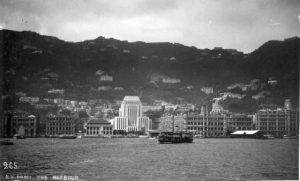
The chapter, “Building on disappearance” discusses the notion of rethinking Hong Kong culture. The writer, Ackbar Abbas held a negative view of Hong Kong’s cultural self-definition in terms of built space and urbanscape. Under the rapid rebuilding of architecture, the city’s spatial culture was reformed constantly without a recognizable consistency. Also, such transformations were taken out by dominating large corporations, resulting in the craving for the image of power. Moreover, the receptivity of global influence and the neglect of local memories also contributed to the disappearing local culture. Although preservations were repeatedly carried out, only the aesthetics or economic values were preserved instead of spaces which reflect local culture. This idea was further reinforced by the author’s examples of Flagstaff House, Bell Tower and Repulse Bay Hotel. The author’s concern was particularly significant at the historical moment of Hong Kong’s handover.
The monumental image of Hong Kong powerful skyline is indispensable to a foreigner’s understanding of Hong Kong. However, culture, constructed by humane activities and interactions could barely be represented by static and placeless facades along the Victoria Harbour. What interested me is the author’s rebuttal on the myth “anonymity is greatly caused by hyperdensity.” It is because this argument is directly coherent to my studio project on Hong Kong’s in between spaces. According to the study by a team of Japanese architects as cited in the reading, hyperdensity with the mixed-up functions without clustering brings heterogeneity and complexity to the community. Such an idea can be reinforced by unique activities by locals, for instance, people in pyjamas strolling in shopping malls. I have recently read a book called Life Between Buildings by Jan Gehl who also suggested that different distances between people can cause different human activities and closer distance stimulate more intimate relationships. It is interesting how the complexity of human activities was constructed by the constraints in space. Back alleys are a great manifestation of such a phenomenon. These random and narrow spaces are shaped by surrounding architectures. The small volume of space increased privacy from the streets and thus encourages privatization and communal activities. It creates a variety of scenes in back alleys. When you are walking in the alleys you can never anticipate what is happening in the next back alley. The natural constraints created a distinctive vibe for Hong Kong.
human activity is an essential part of constructing culture. However, recent architectures tend to neglect it and emphasize the image of power or economic values. If the city is reconstructed repeatedly under such values, local identity can never be defined and Hong Kong will be prone to the cultural invasion with its high receptivity to influences.
Leung Lok Yan
(UID: 3035479729)
Well written arguments, yet careful when you quote someone; you need to mention the page number(s), otherwise I appreciate that you reflect on our tutorials discussion by bringing in your personal point of views into this vital discussion, but especially to extend this discussion to your studio topic. Your interest in weird back alley spaces is now clear to me, and I would love to hear more about your studio investigations. Another constructive feedback I would like to add is that you need to mention your image source. It’s a nice image of the old HSBC bank and Victoria Harbour, and because of that I am even more curious to know from which time this image is. Overall, well done; keep the good work up.